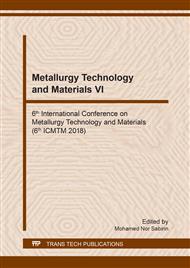[1]
R.Z. Valiev, R.K. Islamgaliev, I.V. Alexandrov, Bulk nanostructured materials from severe plastic deformation, Prog. Mater. Sci. 45 (2000) 103-189.
DOI: 10.1016/s0079-6425(99)00007-9
Google Scholar
[2]
C.C. Koch, D.G. Morris, K. Lu, A. Inoue, Ductility of nanostructured materials, MRS Bull. 24 (1999) 54-58.
DOI: 10.1557/s0883769400051551
Google Scholar
[3]
R.Z. Valiev, A.V. Korznikov, Y.T. Zhu, T.C. Lower, Paradox of strength and ductility in metals processed by severe plastic deformation, J. Mater. Res. 17 (2002) 5-8.
Google Scholar
[4]
R.Z. Valiev, A.V. Korznikov, R.R. Mulyukov, Structure and properties of ultrafine-grained materials produced by severe plastic deformation, Mater. Sci. Eng. A 168 (1993) 141-148.
DOI: 10.1016/0921-5093(93)90717-s
Google Scholar
[5]
R.Z. Valiev, A.V. Korznikov, R.K. Islamgaliev, in: Chow GM, Noskova NI (Eds.), Nanocrystalline materials: science and technology. NATO ASI. Dordrecht, Kluwer Academic Publishers, 1998. p.121.
Google Scholar
[6]
Z.C. Zhou, The influence of Al content on the relaxation peaks in quenched Fe-Al alloys, Mater. Sci. Eng. A 442 (2006) 82-85.
DOI: 10.1016/j.msea.2006.04.136
Google Scholar
[7]
T.S. Kê, Experimental evidence of viscous behavior of grain boundaries in metals, Phys. Rev. 71 (1947) 533-546.
DOI: 10.1103/physrev.71.533
Google Scholar
[8]
Z.C. Zhou, Y.J. Yan, M. Zhong, Internal friction investigation of reverse martensitic transformation in oil-quenched Ni64Al36 alloy, phys. stat. sol. (a) 205 (2008) 2875-2879.
DOI: 10.1002/pssa.200824192
Google Scholar
[9]
M. Weller, H. Clemens, G. Haneczok, The high-temperature damping background in intermetallic alloys, Mater. Sci. Eng. A 442 (2006) 138-141.
DOI: 10.1016/j.msea.2006.02.220
Google Scholar
[10]
Z.C. Zhou, High-temperature background damping in a Fe–25Cr–5Al alloy, Mater. Sci. Eng. A 472 (2008) 166-169.
DOI: 10.1016/j.msea.2007.03.042
Google Scholar
[11]
W.B. Jiang, P. Cui, Q.P. Kong, Y. Shi, M. Winning, Internal friction peaks in pure Al bicrystals with (100) tilt boundaries, Phys. Rev B 72 (2005) 174118.
DOI: 10.1103/physrevb.72.174118
Google Scholar
[12]
W. Benoit, High temperature relaxation, Mater. Sci. Eng. A 370 (2006) 12-20.
Google Scholar
[13]
J.L. Murray, Phase diagrams of binary titanium alloys, ASM, Metals park, OH, (1987).
Google Scholar
[14]
T.W. Duerig, A.R. Pelton, Materials properties handbook: Titanium alloys, Materials Park, OH: ASM International, (1994).
Google Scholar
[15]
D. Feng, Metal physics III (in Chinese), Science Press, Bejing, (1999).
Google Scholar
[16]
J.F. Delorme, P.F. Gobin, Review: phase transition, Metaux corrosion-industrie, 573-574 (1973) 3-32.
Google Scholar
[17]
Y. Hiki, T. Yagi, T. Aida, S. Takeuchi, Internal friction and elastic modulus of bulk metallic glasses, Mater. Sci. Eng. A 370 (2004) 302-306.
DOI: 10.1016/j.msea.2003.07.009
Google Scholar
[18]
T.A.M. Aboki, M.L. Masse, A. Dezellus, P. Ochin, R. Portier, First investigation on twin-rolled Zr59Cu20Al10Ni8Ti3 bulk amorphous alloy by mechanical spectroscopy, Mater. Sci. Eng. A 370 (2004) 330-335.
DOI: 10.1016/j.msea.2003.02.001
Google Scholar
[19]
T.S. Kê, C. Zener, in: A Symposium on the plastic deformation of crystalline solids, Mellon Institute, Pittsburgh, (1950).
Google Scholar
[20]
M. Weller, A. Chatterjee, G. Haneczok, H. Clemens, Internal friction of γ-TiAl alloys at high temperature, J. Alloy Compd. 310 (2000) 134-138.
DOI: 10.1016/s0925-8388(00)00934-8
Google Scholar
[21]
K.W. Yang, E.G. Jia, J.P. Shui, Z.G. Zhu, Crystallization study of amorphous Pd43Ni10Cu27P20 alloy by internal friction measurement, phys. stat. sol. (a) 204 (2007) 3297-3304.
DOI: 10.1002/pssa.200723076
Google Scholar


